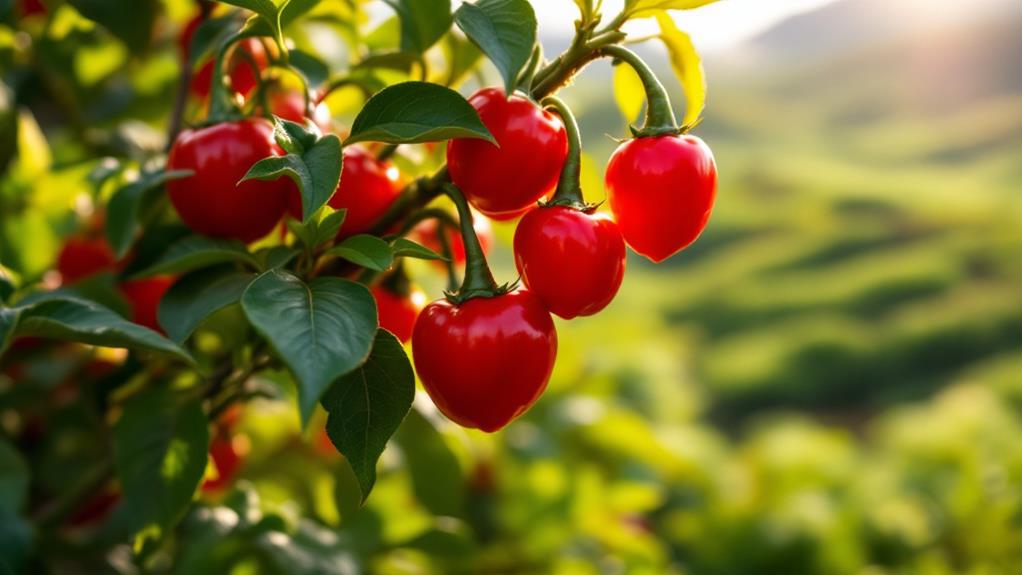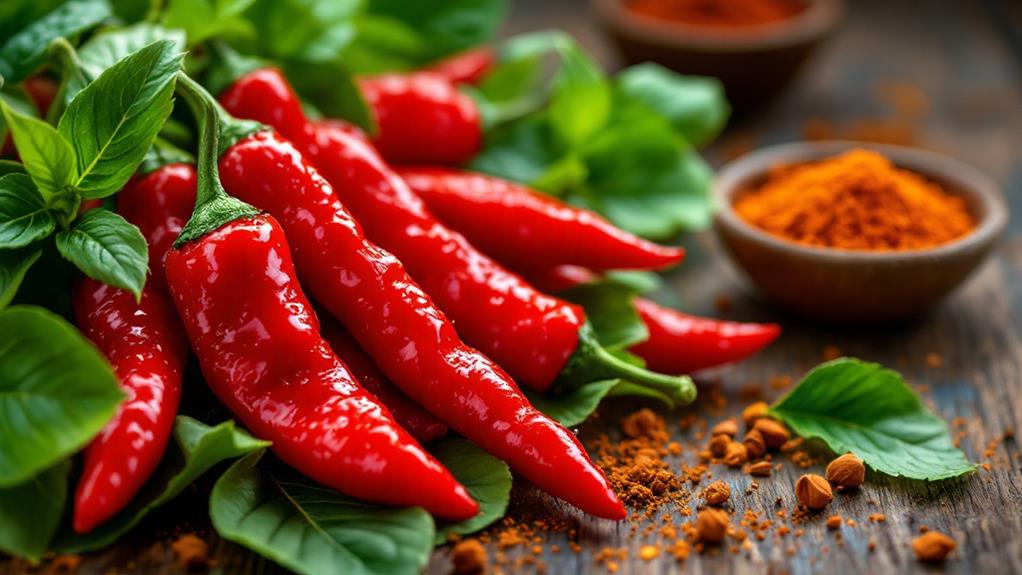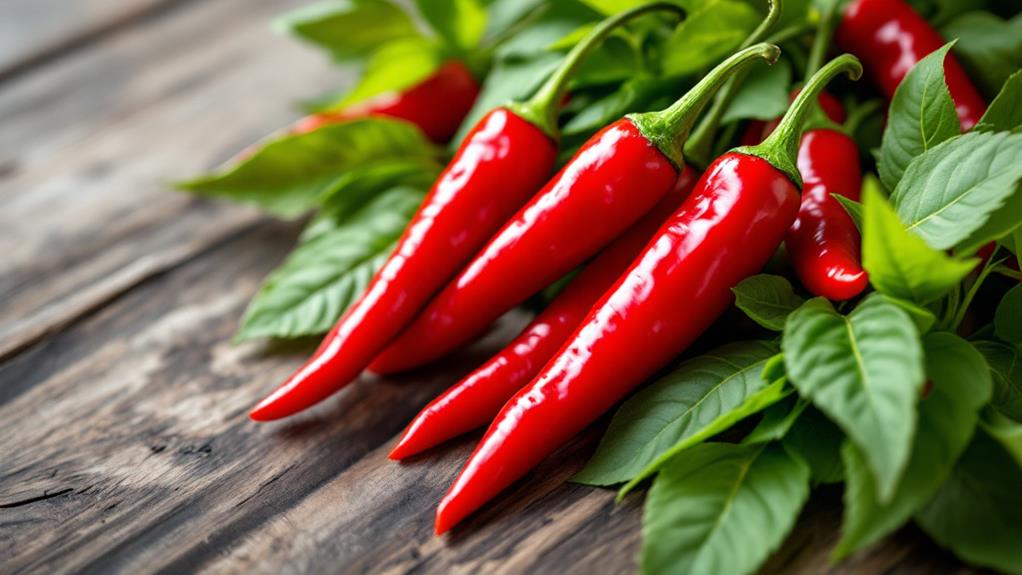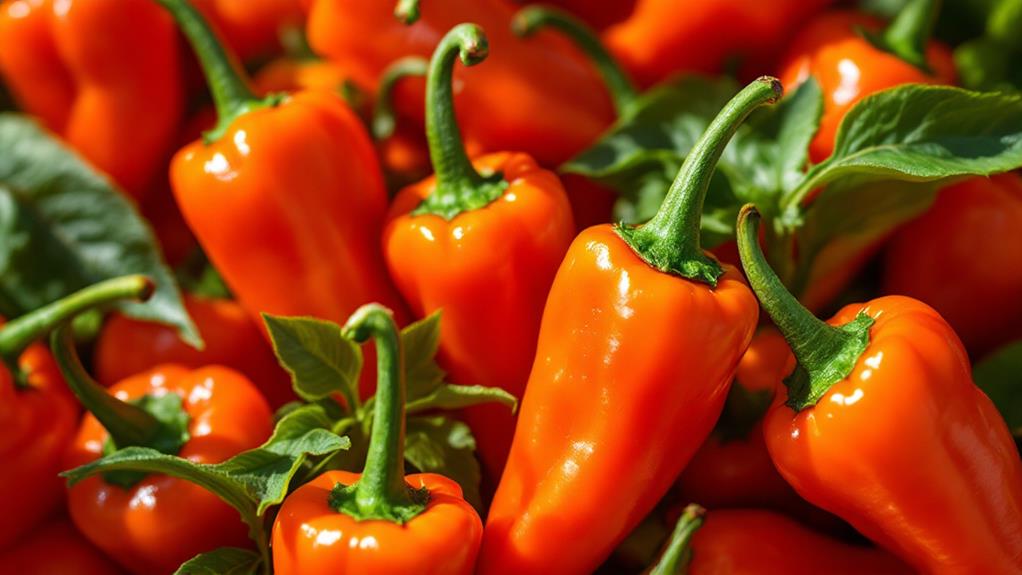Exploring the Yellow Chile Pepper: Flavor, Uses, and Health Benefits
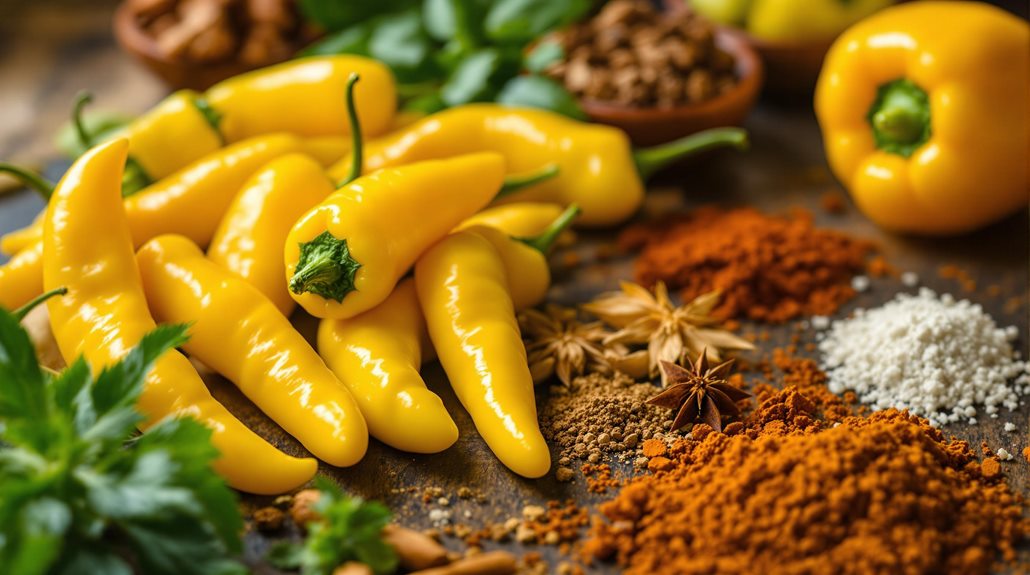
Uncover the lively yellow chile pepper, perfect for adding a fruity, smoky kick to your dishes. With a moderate heat level of 30,000 to 50,000 SHU, it improves ceviche, soups, and stews or even works as a grilled meat topping. Not just a flavor booster, it's packed with vitamin C and capsaicin, offering benefits like improved metabolism, reduced cholesterol, and better immune health. These peppers are ideal in both raw and cooked forms, adding color and taste. If you're curious about its culinary versatility and health perks, there's more to reveal.
Unique Flavor Profile
With their fruity and slightly smoky flavor, yellow chile peppers like the aji amarillo bring a unique depth to any dish. These peppers boast a fascinating flavor profile that's both complex and inviting. Their moderate heat level, ranging from 30,000 to 50,000 Scoville Heat Units (SHU), guarantees they provide a pleasant kick without overpowering your taste buds. The lively yellow hue is thanks to carotenoid pigments, especially violaxanthin, which not only contribute to their distinctive taste but also offer valuable health benefits.
In Peruvian cuisine, yellow chile peppers are a staple, enhancing traditional dishes with their bright color and rich flavor. Regardless of whether in sauces or ceviche, they harmonize beautifully with other ingredients like citrus, garlic, and herbs. This makes them incredibly adaptable in cooking, allowing you to experiment with different recipes and cuisines. Their unique flavor profile means they can seamlessly shift from being the star ingredient to a subtle garnish, adapting to your culinary needs.
Embrace the adaptability of yellow chile peppers in your kitchen. Their balanced heat, combined with health-boosting pigments, offers both a culinary adventure and nutritional perks. You're in for a flavorful expedition!
Culinary Applications
Exploring the culinary applications of yellow chile peppers opens up a world of flavor possibilities. The aji amarillo, a staple in Peruvian cuisine, is celebrated for its fruity and smoky flavor profile. You can use yellow chili in ceviche, where its lively color and unique taste enhance the dish. These peppers shine in sauces and traditional recipes like aji de gallina, complementing chicken with a creamy, spicy twist.
Yellow chiles offer flexibility, regardless of being fresh, dried, or powdered. They're perfect for enriching soups, stews, and marinades. Their adaptability means you can experiment with them in different dishes, enhancing both taste and visual appeal. Consider using them in salsas for added depth and complexity, or blend them into dressings for a fruity kick.
Here's a quick reference for incorporating yellow chiles:
| Application | Form | Result |
|---|---|---|
| Ceviche | Fresh | Lively, fruity flavor |
| Aji de gallina | Fresh/Powder | Creamy, spicy depth |
| Soups & Stews | Dried/Powder | Warm, smoky undertones |
| Grilled Meats | Fresh | Spicy, fruity topping |
| Salsas & Dressings | Fresh/Blended | Complex, tangy notes |
With these culinary applications, yellow chiles become indispensable in your kitchen.
Nutritional Value
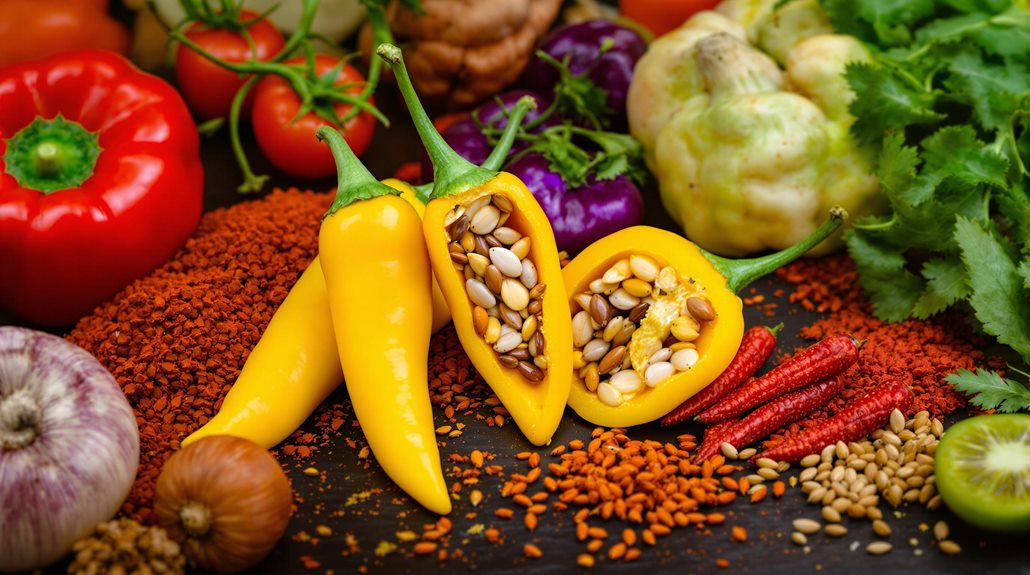
Yellow chile peppers pack a substantial nutritional punch, making them a valuable supplement to your diet. These lively peppers are low in calories, offering only about 18 calories per 100 grams, so they're perfect if you're watching your caloric intake. Despite their low calorie count, they're bursting with nutrients. One of their standout features is their high vitamin C content, providing roughly 135% of your daily recommended intake in just one serving. This enhances your immune system and promotes healthy skin.
In addition to vitamin C, yellow chile peppers contain a notable amount of vitamin A, thanks to their rich carotenoid content, including beta-carotene. This supports good vision and maintains skin health. Moreover, these peppers are a fantastic source of dietary fiber, with about 2.1 grams per 100 grams, helping keep your digestive system in check.
Yellow chile peppers also offer key minerals like potassium and magnesium, which are important for heart health and muscle function. Potassium helps regulate blood pressure, while magnesium is significant for nerve and muscle activity. Including these peppers in your meals not only brings flavor but also enriches your diet with key nutrients.
Health Benefits
Ever wondered why adding yellow chili peppers to your diet can be so advantageous? These lively peppers are packed with impressive health benefits. They're high in vitamin C, providing over 100% of your daily value in just one serving. This vitamin not only supports your immune system but also promotes skin health. The capsaicin found in yellow chili peppers is a game-changer regarding weight loss. It accelerates metabolism, increasing energy expenditure, and helps curb your appetite, making it easier to manage your weight.
Moreover, yellow chili peppers are rich in antioxidants. These compounds play a significant role in protecting your body from oxidative stress and reducing the risk of chronic diseases. In terms of cardiovascular health, these peppers improve circulation and may lower cholesterol levels, contributing to a healthier heart.
| Nutrient/Compound | Benefit |
|---|---|
| Vitamin C | Immune & Skin Health |
| Capsaicin | Accelerates Metabolism & Weight Loss |
| Carotenoids | Supports Eye Health |
The carotenoids, like lutein and zeaxanthin, in yellow chili peppers support eye health and may help prevent age-related macular degeneration. Adding these peppers to your meals can offer a tasty way to improve your general health.
Antioxidant Properties
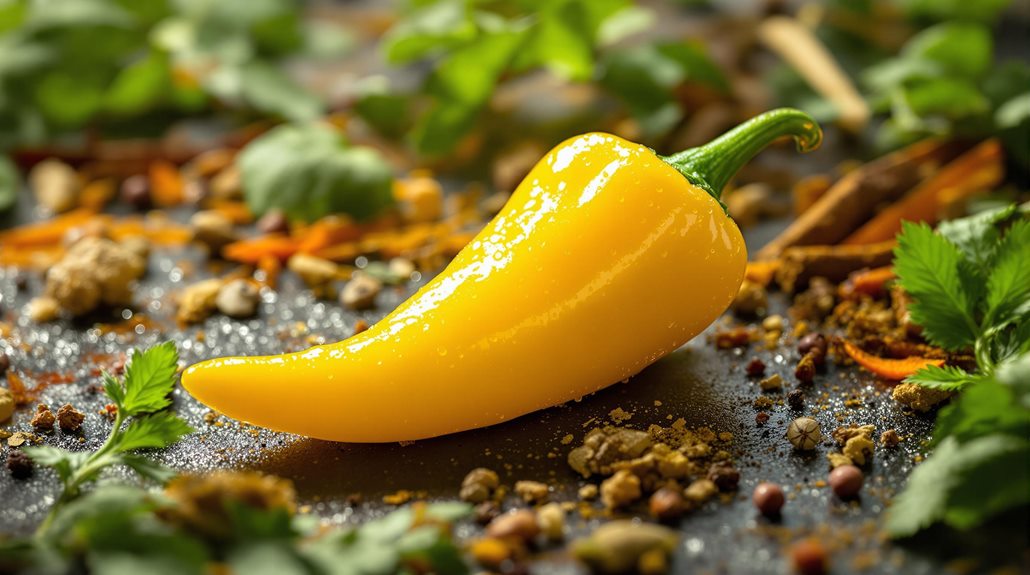
In the lively world of yellow chile peppers, their antioxidant properties steal the spotlight. These vivid peppers are packed with carotenoids like violaxanthin and lutein, which help combat oxidative stress by neutralizing harmful free radicals. You might be surprised to learn that yellow chile peppers provide more than 100% of your recommended daily intake of vitamin C in just a single serving. This powerful antioxidant is crucial for supporting your immune system and maintaining healthy skin.
Capsaicin, the compound that gives these peppers their heat, also contributes to their antioxidant arsenal. It plays a role in reducing inflammation and promoting comprehensive health. Regularly including yellow chile peppers in your diet can enhance your body's antioxidant levels, supporting better health outcomes.
Growing and Harvesting
While yellow chile peppers boast impressive antioxidant properties, growing them in your garden can be comparably rewarding. For ideal growth, plant your yellow chile peppers, like Aji amarillo, in an area with full sun exposure. These peppers thrive in warm climates and need about 75 to 80 days to mature after planting. Your soil should be well-drained and rich in organic matter with a pH between 6.0 and 7.0, supporting healthy root development.
Watering is another vital aspect of growing these lively peppers. Regular watering is important, especially during dry spells, but be cautious not to overwater, as this can lead to root rot. As your peppers ripen, look for a lively yellow-orange color, indicating peak flavor and readiness for harvesting. To harvest, gently twist or cut the peppers from the plant.
Once harvested, you can store your yellow chile peppers in a cool, dry place for up to a week. For long-term preservation, consider freezing them, which retains their flavor and nutritional benefits. With proper care, you'll enjoy fresh, flavorful yellow chile peppers that improve your dishes and offer health benefits.
Cooking Tips and Recipes
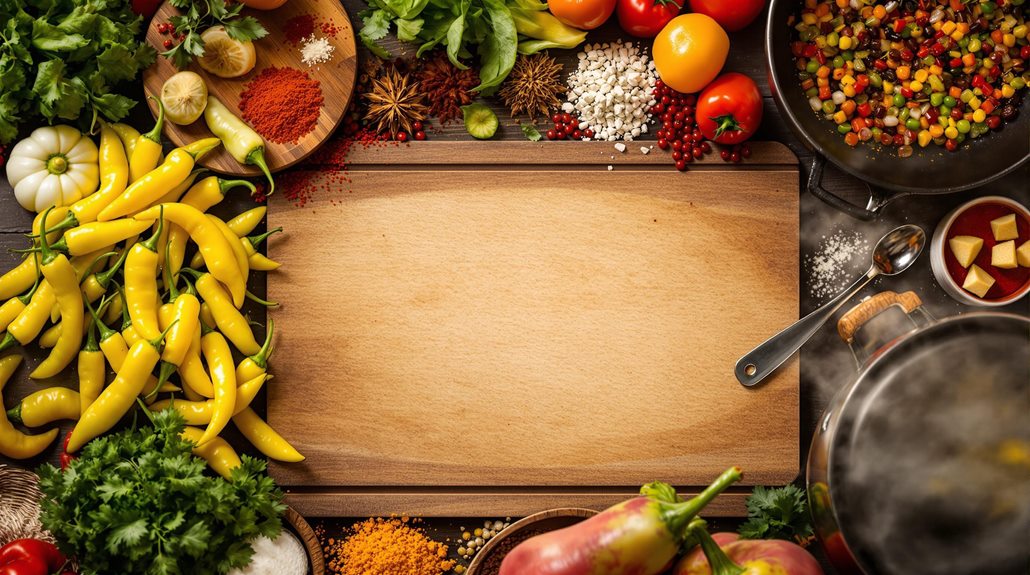
Yellow chile peppers bring a fruity, smoky flavor to your kitchen, making them a versatile complement to countless recipes. These chiles, especially the aji amarillo, are a fantastic enhancement to dishes like ceviche, soups, and stews. To control their heat, consider removing the seeds and membranes; leave them in for a bolder flavor. For an improved taste, roast your yellow chiles by charring them on a grill or under a broiler. This intensifies their sweetness and adds depth, perfect for enriching salsas and sauces.
A standout recipe to try is aji amarillo sauce. Blend yellow chiles with garlic, vinegar, and spices to create a lively condiment that pairs beautifully with grilled meats and seafood. This sauce not only amplifies the dish's flavor but also brings potential health benefits, thanks to the chiles' nutrients.
For a rejuvenating twist, add diced yellow chiles to salads or dressings. Their bright color and unique flavor uplift both the taste and presentation of your meal. By incorporating these cooking tips and recipes, you can fully enjoy the delightful complexity that yellow chiles bring to your dishes.

